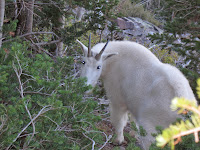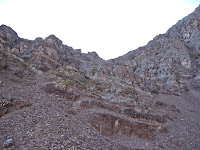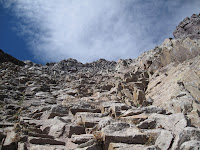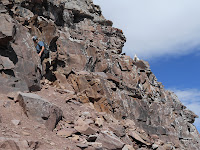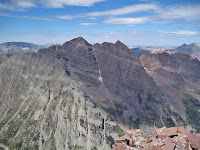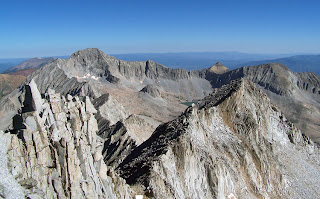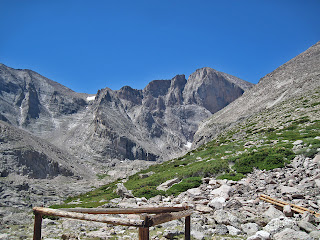 |
| Longs Peak, Mount Meeker, & the Diamond. Shows Pervertical, Kiener's and The Flying Buttress |
It is difficult to go about creating a list like this, as so many opinions exist about each and every one of these routes. I started by first establishing several criteria to reduce the number of worthy candidates to a manageable category. For example, I decided that to be included as a "mountaineering classic" the climb must be a summit route on a mountain higher than 12,000 feet. This eliminated many of Colorado's most classic lines such as The Naked Edge (6 pitches, 5.11b) in Eldorado Canyon, Otto's Route (4 pitches, 5.9) on Independence Monument outside Grand Junction, as well as anything in The Black Canyon or at Lumpy Ridge, etc. All of these climbs were worthy of being listed as Colorado Classics, but were they mountaineering? I considered expanding my criteria to include. But really, they didn't quite fit what I was looking for. I wanted to look at alpine routes, the kind that require a grueling approach and reach the top of a high peak. There seemed to be an intellectual line that defined what "mountaineering" meant, and the need for a strict definition waned.
Sunlight Spire (13,995') (5.10c)
With the 1988 datum bumping up the elevations on most mountains in Colorado, Sunlight Spire now just barely touches the 14,000' mark. However, most mountaineers still refer to the classic 1927 datum, so the Spire is usually still listed at 13,995'. Though it does not have 300 feet of topographical prominence, it holds the title as the hardest 14,000 foot summit in Colorado (if you adhere to the 1988 datum), perhaps in the entire United States. Sunlight Spire is a coveted and elusive summit for the true Colorado mountaineering master.
 |
| Vestal Peak and Wham Ridge |
The unique profile of Vestal Peak's Wham Ridge is unmistakable. It is one of Colorado's most beautiful and most astounding high alpine faces. While the standard Wham Ridge line alone is quality enough to warrant inclusion in this list of classics, the so-called "Center Shift," or direct variation, is the best way to experience the full value of this amazing mountain.
Hallett Peak (12,713')- Culp-Bossier (8 pitches, 5.8+)
The Culp-Bossier route is one of the classic alpine moderates. Located in Rocky Mountain National Park, this little mountain offers big adventure and big rewards. 8 pitches of good climbing including mostly solid rock, runout sections, and some solid "old school" 5.8.
Longs Peak (14,255')- Kiener's Route (5.4, moderate snow)
In my opinion, other than the Diamond, Kiener's Route is the best way to take on Longs Peak. Kiener's is an involved climb, with a long approach, a steep snow couloir, tremendous exposure, a little technical rock and a lot of route-finding. It's other name, The Mountaineer's Route, was given for the multiple skills necessary for a successful ascent.
Jagged Mountain (13,824')- Standard Route (5.2)
Jagged Mountain should be one of Colorado's most coveted mountaineering prizes. It is deep in the wilderness, impossible to see from almost any vantage in civilization, has an amazing route to the top, and is one of Colorado's 100 highest. There is exposure, loose rock, and patience necessary to make an ascent of this unique peak possible. It takes a broad spectrum of mountaineering and backcountry skills to climb reticent Jagged.
 |
| Climbers on the Longs Peak's Diamond |
Any one of the routes on Longs Peak's Diamond deserve to be here. I picked Pervertical Sanctuary for this list. It is the second-easiest way up the Diamond and one of the highest quality in terms of rock and position. Does Longs Peak deserve two routes listed here on this page? It probably deserves more....
Crestone Needle (14,197')- Ellingwood Ledges (5.7)
A mega classic that would deserve to be listed here even if it had not been included in the famous book Fifty Classic Climbs of North America. Other than the numerous routes on Longs this is one of the best technical climbs on any 14er in Colorado. First climbed in 1925 by legendary Albert Ellingwood, this route is steeped in history. It is also very high quality and worth making this list.
The Flying Buttress on Mount Meeker is yet another classic alpine climb in Rocky Mountain National Park. This excellent route follows a salient feature on the Meeker side of the world-class Longs/Meeker cirque that includes Longs Peak's east face and the Diamond. This route is a worthy objective of its own, easier than the Diamond but harder than many other of the classic RMNP climbs.
Petit Grepon (12,000')- South Face (8 pitches, 5.8)
This slender alpine tower was also included in Fifty Classic Climbs, thus cementing its place in the canon of Colorado mountaineering. Besides being a part of this exclusive club, this mountain is fully worthy of being listed as one of the best alpine mountaineering routes in the state in terms of the quality of its rock and of its position. Just don't climb on a weekend or risk having to wait in line for your ascent.
Kit Carson (14,165')- The Prow (5.8)
The Prow is one of the more interesting and unique features on any Colorado mountain. It is an exposed, aesthetic ridgeline that dances up typical Sangre conglomerate cobbles. While most of the route is 5.6 or easier, the crux comes as the first move, committing you to the route. Escape is difficult and the exposure is amazing. A true alpine classic.
RELATED ARTICLES
Ten Class 3 Colorado Classics- for those too timid or too inexperienced for the class 5 list, check out these classic class 3 scrambles.
Visit THE ARCHIVE: A list of most of our articles sorted by department






